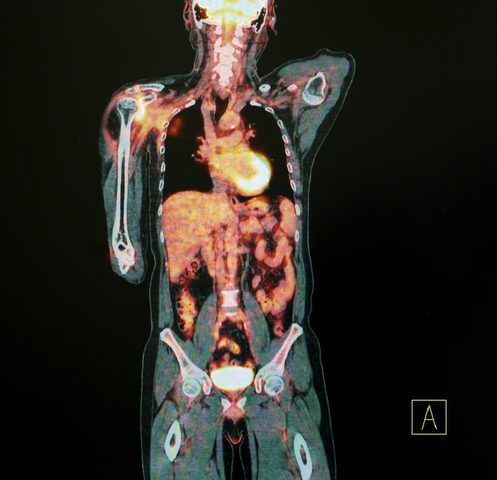Among men suspected of having prostate cancer recurrence after surgery, the radiotracer 68Ga-PSMA-11 is better at detecting the cancerous lesions and provides better agreement among experts than the standard Axumin (18F-fluciclovine) tracer, a Phase 2 trial shows.
The results were presented at the 2019 Society of Nuclear Medicine and Molecular Imaging (SNMMI) Annual Meeting, held June 22–25 in Anaheim, California. The communication was titled “68Ga-PSMA-11 PET/CT detects prostate cancer at early biochemical recurrence with superior detection rate and reader agreement when compared to 18F-Fluciclovine PET/CT in a prospective head-to-head comparative phase 3 study.”
Radical prostatectomy — surgery to remove the prostate and surrounding tissues — is among the most common treatment options for prostate cancer. However, up to 40% of patients see their PSA levels increase after surgery. This process, called biochemical recurrence, indicates the return of cancer.
Doctors use various imagining methods to estimate the size and location of recurrent tumors before starting treatment. However, traditional techniques such as computed tomography (CT), magnetic resonance imaging (MRI), and bone scans often fail to detect small tumors, especially at the early stages of biochemical recurrence, when PSA levels are low.
Positron emission tomography/computed tomography (PET/CT) is a highly sensitive imaging method that uses radiotracers — molecules that target specific cellular components, linked to small amounts of radioactive materials — and a special camera and computer to evaluate the function of different tissues. Researchers have developed radiotracers that specifically label components of prostate cancer, thus allowing its detection at earlier stages.
Axumin, by Blue Heart Diagnostics, is a radiotracer indicated to identify suspected sites of prostate cancer recurrence. It is a synthetic amino acid that preferentially enters prostate cancer cells due to their increased amino acid transport, labeling them with the radioisotope F 18.
On the other hand, the 68Ga-PSMA-11 tracer consists of a molecule that binds the prostate specific membrane antigen (PSMA) labeled with the radioactive compound gallium. This radiotracer can detect prostate cancer safely and accurately, but has not been compared with standard Axumin in clinical trials.
The Phase 2 trial (NCT03515577) compared the efficacy of PET/CT using either 68Ga-PSMA-11 or Axumin at detecting prostate cancer in 50 men with early biochemical recurrence, whose PSA levels ranged between 0.2 and 2 ng/mL.
Participants underwent Axumin PET/CT within two weeks before or after 68Ga-PSMA-11 PET/CT, and results were assessed by three independent imaging experts.
The study’s main goal was to compare the detection rates by patient and region. Secondary measures included detection rates according to initial PSA levels, the accuracy of each method, and agreement among readers.
Researchers found that the 68Ga-PSMA-11 tracer helped the experts identify prostate cancer lesions in significantly more patients (56%) than Axumin (23%). The PSMA tracer also identified more lesions by region — 30% versus 8% in the pelvic area, and 16% versus 0% in the extra-pelvic area.
Finally, readers agreed more on the results of this tracer, both by patient and by region.
“In patients with [biochemical recurrence] and low serum PSA levels after [radical prostatectomy], PSMA PET/CT has higher detection rates and better reader agreement than [Axumin],” researchers concluded. “Therefore, PSMA PET/CT should be the imaging modality of choice in patients with early [biochemical recurrence].”

